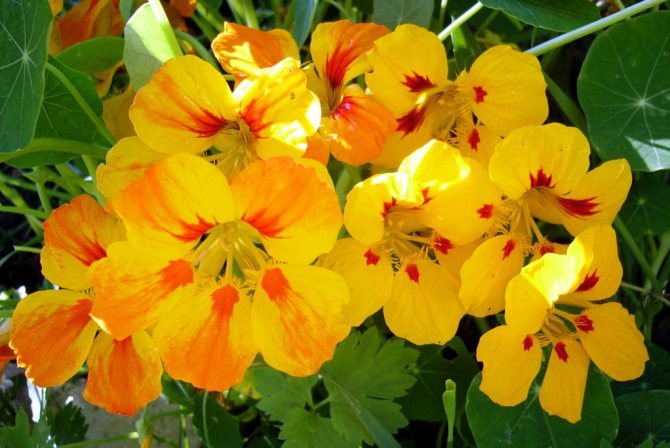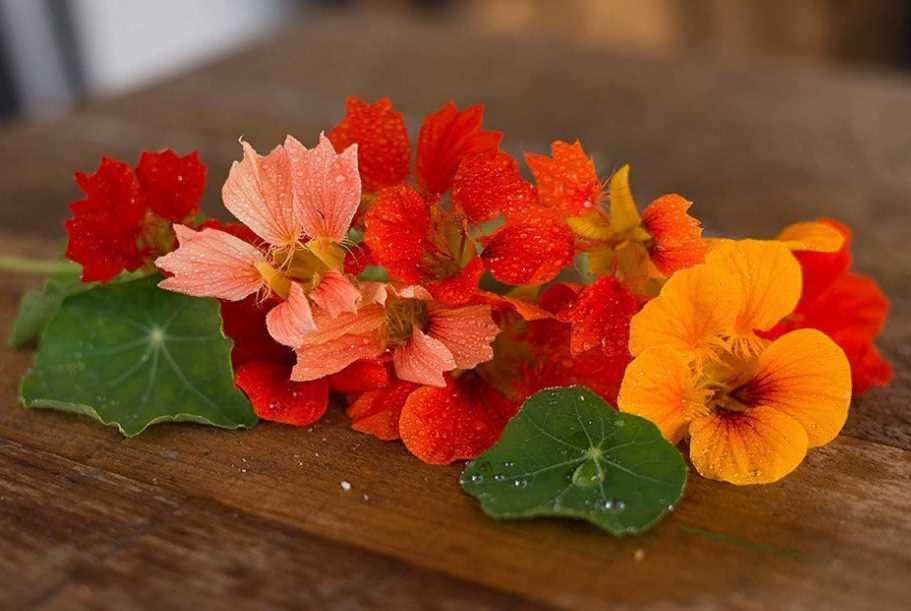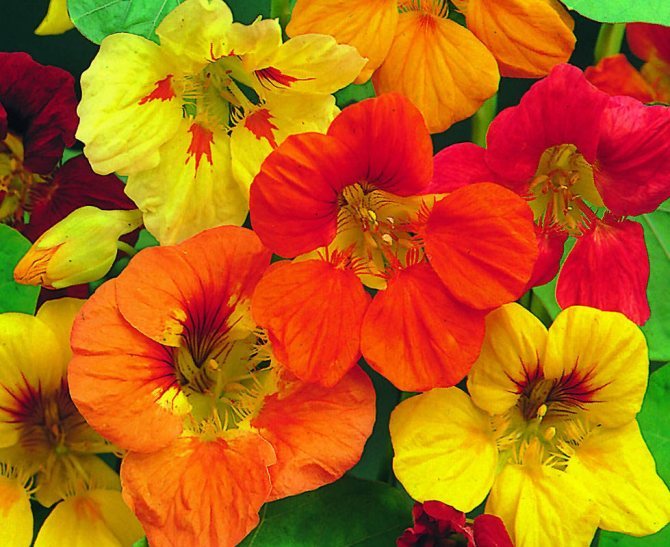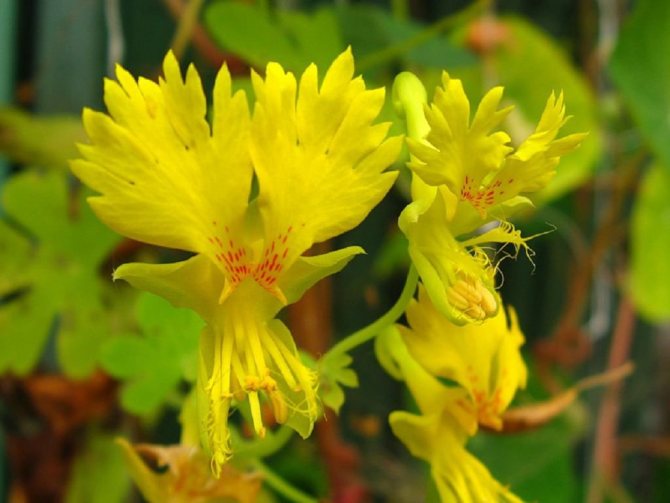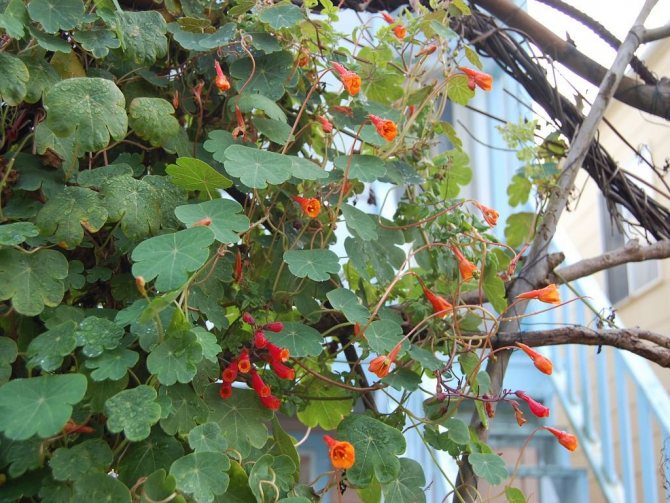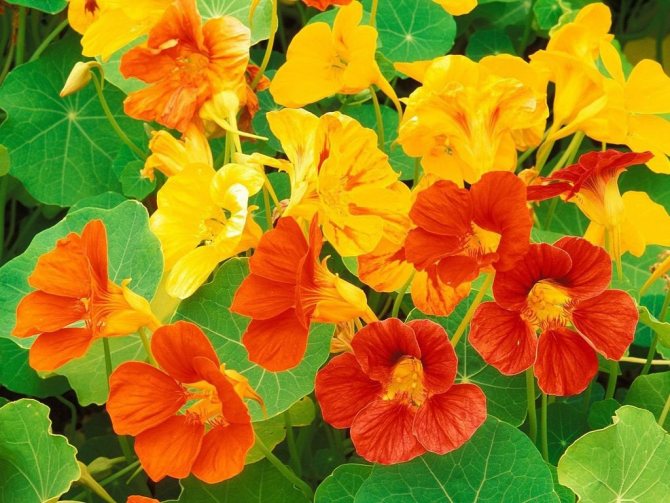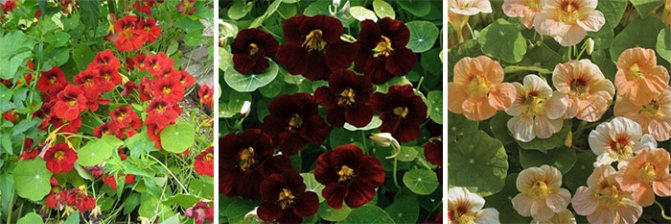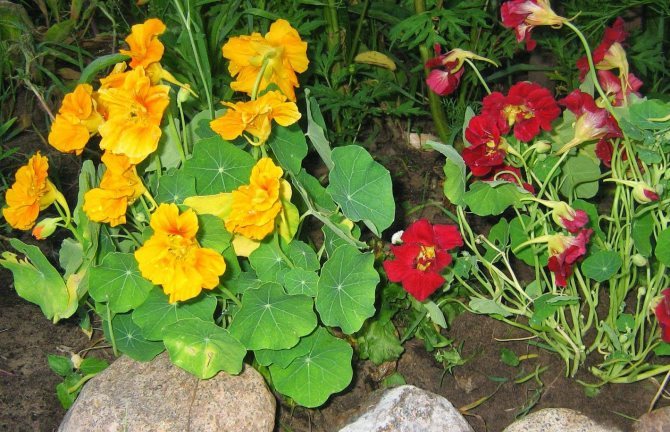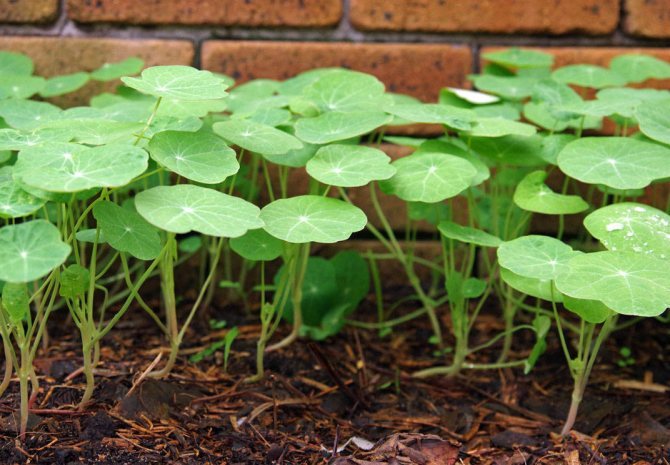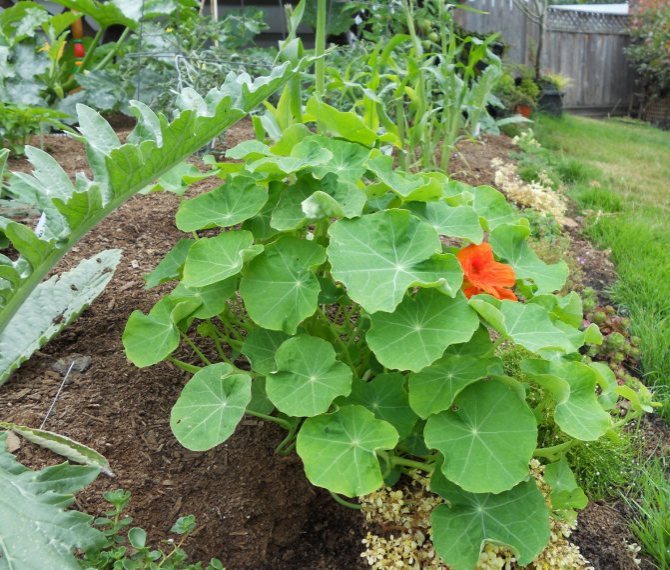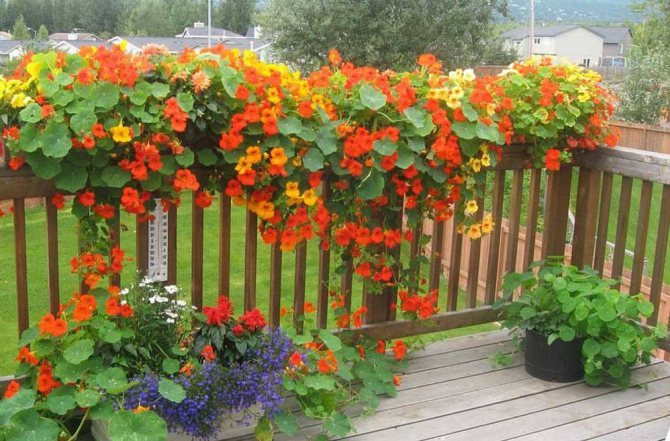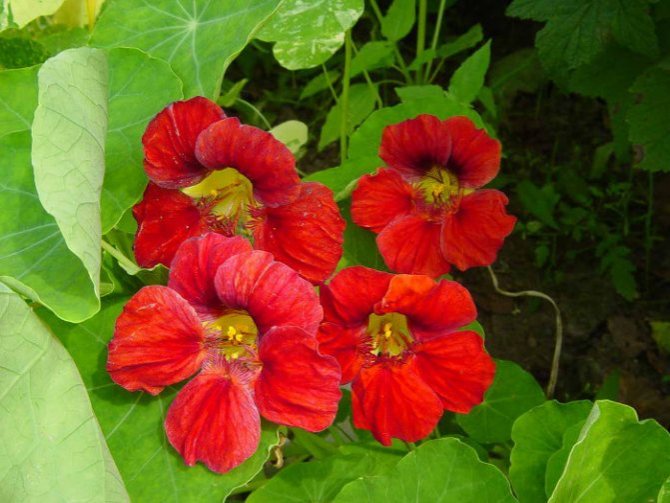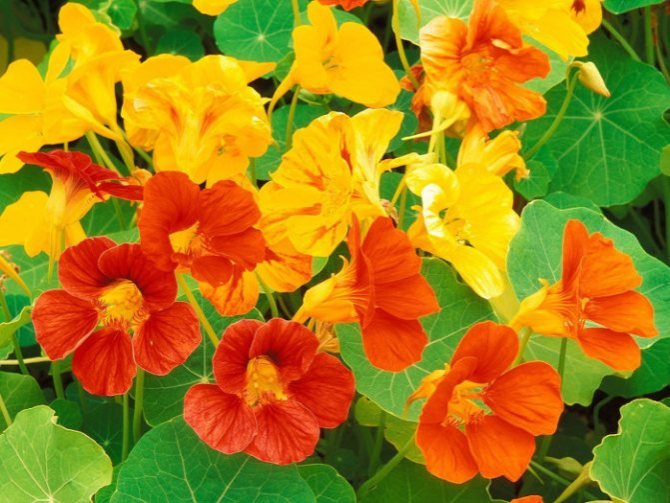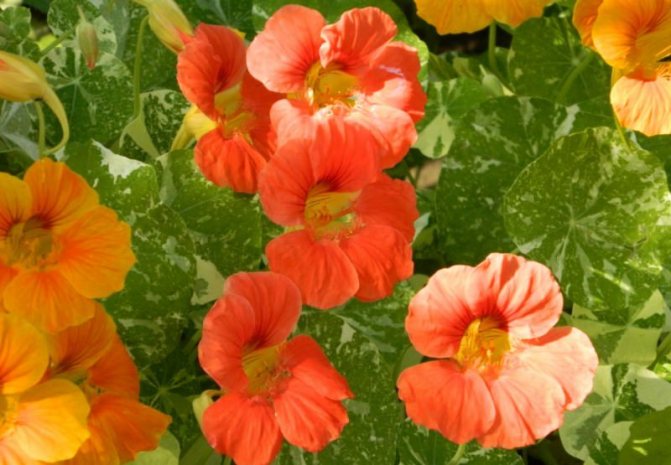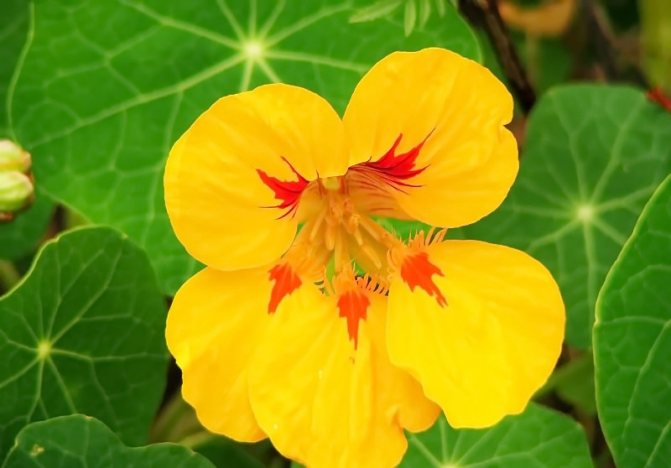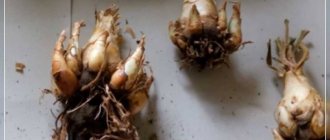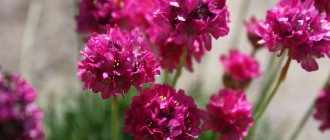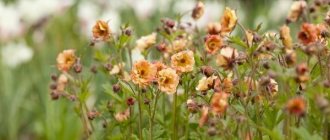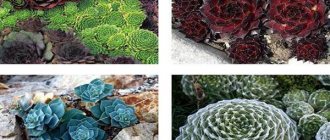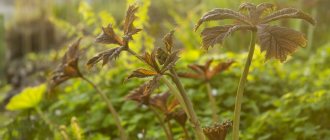Small creeping shrubs with juicy green leaves and bright funnel-shaped flowers of bright orange or yellow color are often found in gardens of the middle lane, in summer cottages and in balcony cassettes. These flashy flowers, flaming against the backdrop of bright greenery - nasturtium.
Nasturtiums have become so familiar that we do not see anything unusual in them, and yet this is not just a beautiful plant.
Surprising Nasturtium Facts:
- The tubers that form on the roots of some perennial nasturtium species are edible and taste good.
- You can eat not only the roots of the flower. Young shoots and leaves are used as an ingredient in lettuce, buds and green fruits are salted or pickled, and seeds are used as a spice to a wide variety of dishes.
- Green ovaries of nasturtium fruit are sometimes used in place of capers.
- Nasturtium is considered a medicinal plant that helps to cure respiratory and digestive diseases, as well as skin ailments. Nasturtium is rich in vitamins C and A, and therefore is used for the prevention of vitamin deficiency.
- The original name of nasturtium - Capuchin - came from the similarity of flowers to the pointed hoods of Catholic Capuchin monks.
- In the setting sun, the flowers of nasturtium seem to flare up and burn with bright fiery colors.
Nasturtium, also known as capuchin, is a large genus of herbaceous plants. In the Latin classification, the genus is called Tropaeolum and is divided into many species and subspecies. Nasturtium gave its name to a whole family of dicotyledonous cabbage plants, whose homeland is considered to be Central and South America. Among more than 90 species, there are both annuals and perennials. Unfortunately, in the rather harsh conditions of the middle zone, nasturtiums do not tolerate wintering in the open field, therefore only one-year-olds are used in gardening.
In the article we will consider the main types and varieties of plants, their features and use for decorative purposes, as well as provide some recommendations for plant care.
Nasturtium can often be seen in pots on balconies and walls, as well as outdoors. Growing it is not difficult, but still there are features regarding planting and such an interconnected procedure as care. All this is described in our article.
Varieties and varieties of nasturtium
There are over 45 types of nasturtium. The plant comes from the warm regions of America, where it is mainly perennial. Our frosty winters do not leave any chance for her to overwinter, so nasturtium is more often grown here as an annual. The following cultural types are popular:
Canary - is a liana with stems up to 3.5 m, where bright yellow flowers, up to 20 mm in diameter, resembling a small bird in shape, stand out against the background of light green five- or seven-part leaves. Blooms from June to December.
Canary nasturtium
Big - a shrub with large thyroid leaves, with long and thin stems, sometimes growing up to 250 cm. Flowering begins in July and lasts until November. There are many varieties of this species.
Large nasturtium
The following are popular:
- King Theodore;
- Peach Melba;
- Salmon Baby;
- "Ladybug".
Small - the diameter of flowers is only about 30 mm, the stems are short - up to 0.35 m. The most common varieties are Black Velvet and Cherry Rose.
Small nasturtium
Shield-bearing - a plant with 4-meter shoots, with scarlet or red flowers that appear in June. Mainly 1 variety of this ground-covering flower is grown - "Lucifer".
Shield-bearing nasturtium
Cultural - a species obtained as a result of crossing large and shield-bearing. There are 2 subspecies: creeping and dwarf. The most common seeds of the following varieties are on sale:
- Moonlight;
- Golden Globe;
- "Glamming Mahagani".
Cultured nasturtium
Planting and caring for nasturtium
A flower such as nasturtium, the cultivation and care of which does not cause much trouble for flower growers, is a good decoration of the site, which is confirmed by numerous photos taken by summer residents and designers. Let's consider all the stages of its cultivation.
Before planting nasturtium, you should choose the right place. Strong drafts and shade are contraindicated for her. The characteristics of the soil also play an important role. Regardless of the type and variety, nasturtium loves slightly acidic, fertile, light soil and good drainage. On heavy clay soils, the roots rot and the plant dies. Watering this plant must be treated with caution. Capuchins are uncomfortable in excessively moist soil, but at the moment when sprouts appear and their active development begins, watering is necessary. If all the rules of care are followed, nasturtium will bloom 45 days after germination.
Be careful and follow the nasturtium watering regime
When nasturtium blooms, the number of waterings is reduced, watering only in prolonged drought. They also remove wilting flowers, normalize the amount of ovary, get rid of weeds, mulch the soil around the bushes. If you plan to get your own seeds, then the large ovary should be left to mature. In the south, seeds that have fallen to the ground sprout in spring, but experienced growers advise against growing nasturtium in this way. Seeds should be harvested in the fall and sown in the ground in the spring according to all the rules. If, before the onset of frost, nasturtium still blooms profusely, then given that it cannot winter in our latitudes, it is placed in flower pots and brought into the room. It will be good for her on a bright but cool window.
Nutrients for nasturtium
Fertilization and feeding are also necessary for the normal development of nasturtium. True, it is not worth fertilizing the beds intended for it with fresh manure - the plant does not tolerate it. The earth is mixed with rotted manure, but if it is not there, then the store sells special preparations in the form of superphosphate and potassium sulfate. They are brought in quite a bit - per 1 sq. m teaspoon.
Feed regularly
Before the plant begins to bloom, experts advise feeding with potassium-phosphorus fertilizers in order to cause abundant flowering. Sometimes nasturtium leaves yellowing, and not only the lower ones, but also the upper ones. One of the reasons may be a lack of minerals. Correct the position of the introduction of azofoska
Attention: do not get carried away with fertilizers containing a lot of nitrogen fertilizers, otherwise nasturtium will not bloom at all or very weakly.
Disease and pest control
Although nasturtium repels whitefly, aphids, Colorado potato beetle and cabbage, it also has diseases inherent in it. Affects Capuchins:
- bacterial wilting, when the lower leaves first disappear, and then the whole plant disappears;
- gray rot, declaring itself with dry gray-brown spots on leaves and shoots;
- rust, as evidenced by small black and brown spots that turn into bumps;
- mosaic - manifests itself as a mosaic pattern on the leaves;
- ring spot, when the leaves are covered with small dots surrounded by a reddish-brown border.
Gray rot on nasturtium leaves
The affected parts of the plant are removed and burned, and the rest is treated with chemical or bacteriological preparations.
Reproduction of nasturtium
Nasturtium, both annual and perennial, is mainly propagated by seeds and seedlings, but sometimes growers, when growing new varieties, follow a more complicated path - they root young cuttings.
Before planting the seeds, they are placed for a very short time in water heated to 40 degrees C, then soaked for 24 hours. They are sown only in well-heated, dug and leveled open ground. In the garden, holes are made with an interval of 25 cm, 2 seeds are thrown into them. If even at the end of spring there are frequent cold snaps, then the bed for planting capuchins is watered with well-heated water, and after sowing the seeds, it is also covered with a film.
Nasturtium seeds
Nasturtium grown through seedlings will bloom much faster. It is better to plant the planting material in peat cups so as not to touch the delicate roots during transplantation. Sprouts at room temperature usually show up in a week and a half. From that moment on, the best conditions for their normal development are a temperature of 18 degrees and a lot of light. Transplantation to a permanent place is permissible after the establishment of stable heat.
Terry, expensive varieties of nasturtium require more attention, planting and caring for it are also appropriate. Propagated by cuttings previously placed in water or wet sand. When the roots appear, they are transferred into separate peat cups filled with loose fertile soil. In the future, shoots are planted in a garden bed or in a pot.
Seedlings of nasturtium
Nasturtium in combination with other plants in landscape design
An easy way to redesign a site is to grow nasturtium. Florists consider it one of the best crops for decorating a manor, and often photos of bright fragments of the landscape confirm their correctness. The main thing is to find a place corresponding to a certain type of this plant. Curbs and mixborders are created from bush capuchins. They also look great in large tubs, hanging pots. The place around trees and along the walls is most suitable for large nasturtium.
Nasturtium in landscape design
Curly fragrant nasturtium is an excellent material for hedges, gazebos, balconies. White, purple climbing capuchins work very well with the vibrant blooms of double petunias in the foreground or other short flowers.
Tip: plant a colorful capuchin in the cabbage bed, and then the whitewash will not destroy the crop, and use the capuchin leaves and green seeds for salads.
Petunia is not only a beautiful but also a useful plant. It is both a decoration for the site, and a repeller for many pests, and an exotic addition to dishes.
Useful properties of nasturtium: video
Nasturtium: photo
Features of nasturtium
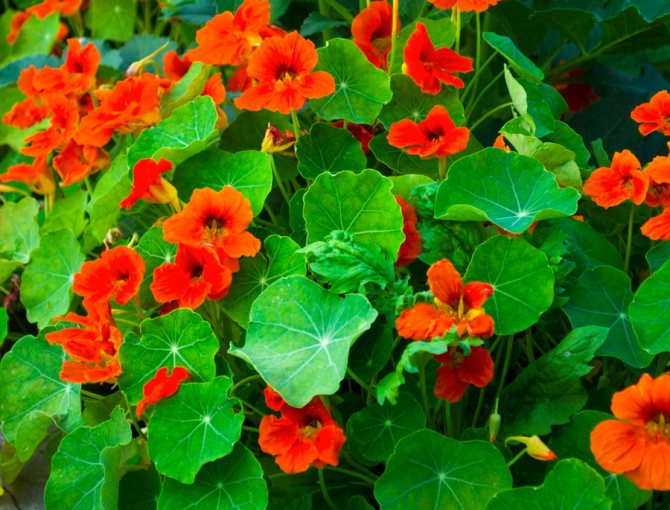
Nasturtium is a perennial or annual plant. Often it is a liana with succulent shoots, less often dwarf shrubs. Often, the leaf plates are alternately lobed, whole-edged, thyroid or palmate-divided. Fragrant flowers can be double, simple or semi-double. They are zygamorphic, irregular, axillary and bisexual. They include 5 petals (in some cases more), the same number of sepals, and a funnel-shaped tube with nectar inside. The flowers are most often colored yellow or red. The fruit consists of 3 kidney-shaped wrinkled lobes, and in each of them round-kidney-shaped seeds ripen.
The shoots and flowers of this plant are distinguished by medicinal properties, and they are also used in the preparation of various culinary dishes.
Types of nasturtium
The flower is distinguished by an increased variety: there are more than 90 plant species, and each is divided into varieties. But only a few subspecies are especially popular with gardeners.
Big


It has single large flowers of scarlet, burgundy, peach, salmon, yellow shades. Some hybrid representatives have multi-colored flowers. Shoots stretch up to 3 m in length.
Canary


The flowers are very beautiful: the shade is bright yellow, a greenish spur is hidden in the bowl, the petals are corrugated. Vines can stretch up to 3.5 m.
Tuberous
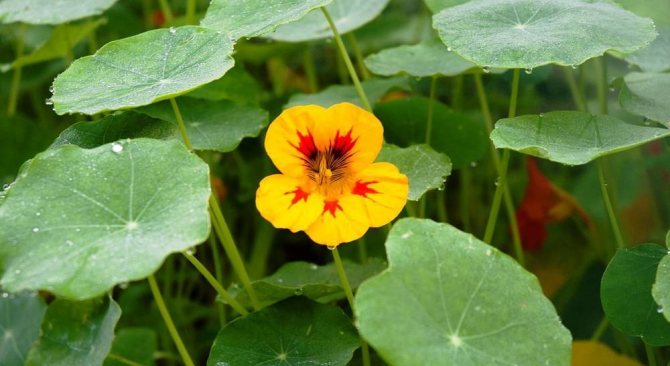

Vines are covered with tiny lemon-red flowers. They are often planted in home growing pots.
Shield-bearing


Stems are dark emerald, 4 m long and very fragile. The flowers are fiery red, up to 6 cm in diameter.
Cultural
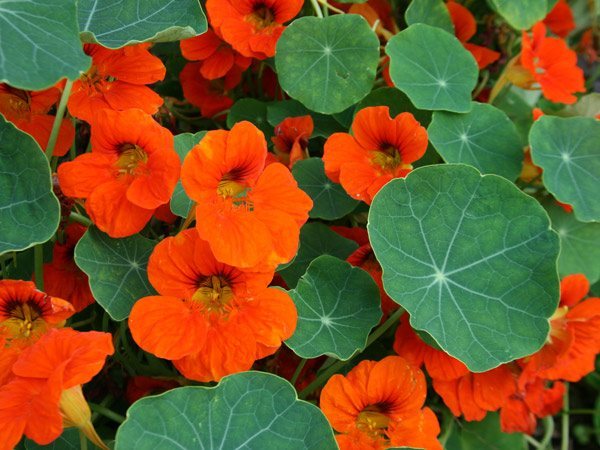

The leaves are dark green with a barely noticeable burgundy tint. The color of the corollas is varied: from pale yellow to rich orange.
Small


Shoots are collected in a small dense subshrub no higher than 35 cm. Flowers differ depending on the variety. The most popular are “black velvet” with black and burgundy buds and a cherry rose with scarlet double flowers.
Description of the plant and the origin of the name
Nasturtium is one of three genera of the family of the same name, a herbaceous plant with succulent stems, which can be annual and perennial, erect and creeping, climbing and hanging freely from a cliff or from a hanging basket.
Nasturtium leaves in their appearance resemble the spread fingers of a copepod frog, the same round, marsh-green and sinewy. Karl Linnaeus saw barbarian shields in the form of the leaves of this plant, which the ancient Roman warriors nailed to trophy columns - tropheion. This is how the Latin name of the genus Nasturtium - Tropaeolum appeared.
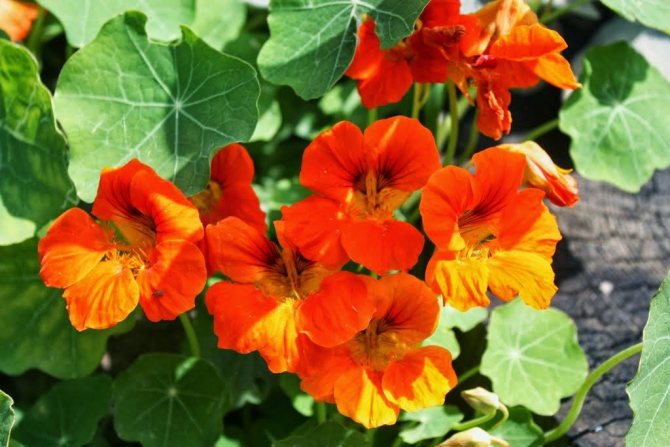

Nasturtium leaves in their appearance resemble the spread fingers of a copepod frog
The main decoration of the plant is a large, up to 6 cm in diameter, flower with a spur at the end of the funnel. It resembles the pointed hood of a monk of one of the medieval orders thrown off his head, for which the plant received its second name - capuchin.
The most curious is the origin of the most popular plant name. The Latin word Nasturtium in the Renaissance was for watercress. When nasturtium spread as an edible greenery, the name "Indian watercress" - Nasturtium indicum was chosen for it. So the overseas beauty took the name from the tasty, but inconspicuous grass.
In culture, the nasturtium flower is represented by several types:
- big - an annual plant with flowers of the entire palette of yellow, cream and red shades;
- tuberous (anyu) - perennial with underground tubers rich in starch;
- foreign, or "Canary liana" - curly perennial with lobed leaves and original flowers in the shape of a dragon's head.
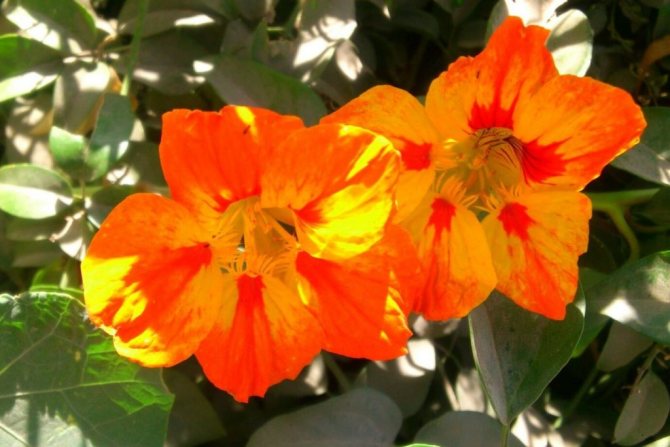

The main decoration of the plant is a large flower with a spur at the end of the funnel.
Capuchin varieties
Magnolia: flower
Among the popular varieties of crops are:
- Pink cherries;
- Ladybug;
- King Theodore;
- Alaska.
Pink cherry
The nasturtium of the Pink Cherry variety is a compact bush, up to 33 cm high. At the same time, the flowers are rather large in relation to the stems and leaves. Each flower grows up to 5-7 cm. The color is pink, lilac-cherry. A distinctive feature of the variety is its pleasant floral-honey aroma.
ladybug
The ladybug is a variegated Capuchin variety. The color of the petals is beige-sunny or gold with tangerine splashes. The flowering is profuse and long lasting. The ladybug is a large nasturtium species.
King Theodore
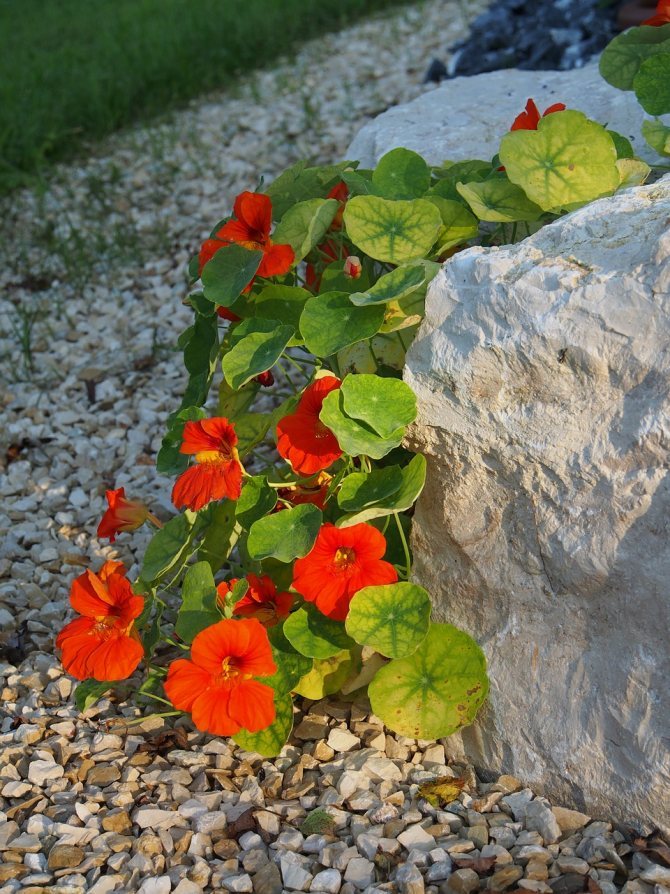

King Theodore
The King Theodor variety is distinguished by a rich scarlet or red color of flowers. The structure of the petals is terry. The leaves are emerald in color.Bushes are dense, powerful, usually in the shape of a circle. The height of each is 35-44 cm.
Alaska
Nasturtium Alaska is a small annual. Flowers have different colors. A feature of the variety is variegated sheet plates of irregular shape. They are light green in color with whitish strokes.
About nasturtium
The nasturtium flower is a representative of the huge Nasturtium family. The plant is often found in vegetable gardens and garden plots. It stands out among other crops for its dense greenery and bright colors. Inflorescences can have different colors: be red, orange, yellow. Now the capuchin is distributed all over the world. It grows in both warm and cool regions. America is the homeland of an unpretentious culture. For the first time, nasturtium flowers were seen in the central and southern parts of the continent.
History of the name
In Latin, the name is spelled as nasturtium. Literal translation means to cut or torment the nose. This name was given to the plant because of its intense persistent odor. The flower was named capuchin for its appearance. The flowers are shaped like a monk's hood. We are talking about the ministers of the Capuchin order who lived at an ancient monastery in one of the cities of Portugal.
Why culture is bred
The plant fits perfectly into any garden. They are decorated with hedges, fences, gazebos, since the stems of some varieties look like vines. The varieties that are near the ground are used to decorate flower beds, tree-trunk circles of fruit trees and shrubs, and framing footpaths.


Nasturtium flower
Nasturtium feels good at home and in pots on the balcony. The balcony, decorated with capuchin thickets, looks well-groomed.
Important! The bush flower is a green manure, that is, it improves the properties of the soil. Thanks to nasturtium, the soil becomes more fertile. In this case, the capuchin does not need to be embedded in the soil during the summer season. The plant is allowed to bloom freely until late autumn. During flowering, capuchin repels harmful insects.
In addition, nasturtium has found application in cooking. The attractive plant is prized for being edible. The leaves and petals taste like watercress. These parts are used to prepare and decorate various dishes. Nasturtium is especially popular in the cuisine of Americans living in the south.
Beneficial features
Nasturtium is a healthy culture.
Leaves and flowers contain important substances:
- Vitamins C, A, PP;
- Carotene;
- Phosphorus;
- Magnesium;
- Potassium;
- Calcium;
- Folic acid, linolenic acid;
- Copper;
- Iron;
- Omega-9, etc.
Thanks to this composition, the benefits of nasturtium flowers are great. Leaves and flowers of nasturtium have medicinal properties. Capuchin has a positive effect on immunity, general body tone, digestive processes, circulatory system, strengthens vision and prolongs youth. If you add flowers as an ingredient to salads and main courses, you can heal from colds and overcome depression. A light, medicinal and spicy girlish salad is prepared from nasturtium, radishes, onions and cucumbers.
Additional Information. You should not use capuchin for pregnant and lactating women, people suffering from ulcers, gastritis, diarrhea.
Plant characteristic
Many people are interested in the question: "is nasturtium an annual or a perennial?" Capuchin can be both perennial and annual. In the gardens of Russia, an annual flower is usually grown, since nasturtium does not tolerate frost and dies during the first frost.
What does nasturtium look like? The plant is a liana-like thicket with a large number of leaves. There are species with branched, creeping or semi-erect shoots. The height of the semi-shrub reaches 30-40 cm. Vine stems stretch up to 2.5 meters. Shoots can be either light green or dark emerald with a brick tint. The color of the stems depends on the type of capuchin.
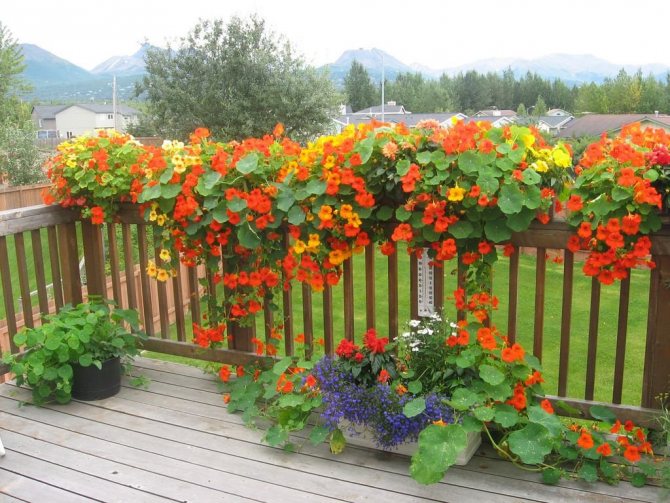

Nasturtium flower in landscape design
The nasturtium leaf plates are remarkable, they look like rounded shields or lobes. They resemble the leaves of water lilies in shape. The petioles are elongated.
The root system is pivotal. The main root is powerful. Lateral roots grow sparsely. They are located close to the surface of the earth, at a depth of 5-10 cm.
Flowers of irregular shape, solitary, grow from the axils of the leaves. Each flower is large - about 4-6 cm. Depending on the type, they are smooth, double. They have a pronounced aroma. The color is always bright. There are capuchin pink, yellow, purple, tangerine, beige, cherry, white-purple, red. Flowering begins in June and lasts until autumn. A description of flowers would be incomplete without information on pollination. Insects pollinate nasturtium.
After flowering ends, fruits appear. The fruit is predominantly green in the form of a medium-sized dense box with three valves. There are seeds inside. They are covered with a yellowish film. Each seed is about 0.4-0.6 cm in size.
Reproduction methods
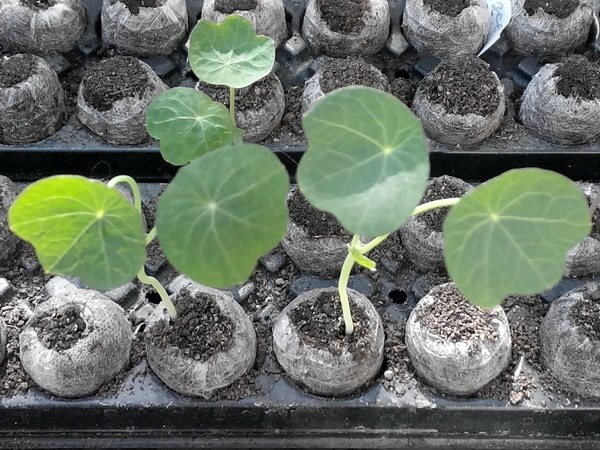

The most convenient and popular planting method is seed. Basically they are planted directly in the ground, for earlier flowering, seedlings are germinated. But some gardeners prefer vegetative propagation.
Seed planting
Sowing in open ground is preferred. Seedlings are relevant only if there are risks that nasturtium will sprout for a long time (cold climate or the possibility of frost).
The plant is sown into the ground after the snow melts and the repeated frosts leave (in mid or late April). It is necessary to prepare grooves at a distance of 25-30 cm from each other with a depth of no more than 2 cm. It is better to put 3-4 seeds side by side to get a lush rosette. The seeds are sprinkled with earth, and if it is cool outside, they are covered with foil. The first shoots should appear in 12-15 days, and flowers in 30-45 days.
Germination of seedlings consists of several stages:
- Fill small containers or peat cups with soil, make holes 1.5–2 cm deep.
- Place 2-3 seeds in each, compact the soil and spray with a spray bottle.
- Place for 2 weeks in a warm place with an air temperature of + 20 ... + 22o C.
- When the first shoots appear, reduce the temperature to + 18o C. The pots must be rearranged to light, as in a dark place the stems will quickly stretch out.
Small nasturtiums have a very weak root system, so they cannot be dived. Seedlings are sown in single pots and transferred into the ground with an earthen clod.
Cuttings
Vegetative propagation will help to ensure that the varietal traits of a healthy parent plant are preserved. The planting process looks like this:
- A healthy shoot with 3-4 leaves is cut off from an adult plant. The lower cut is treated with "Kornevin".
- For the sprouting of the roots, the cuttings are placed in a container with water or wet sand.
- When the first roots appear, the flowers are transplanted into small containers or directly into the ground on the site. In this case, it is important not to harm the delicate roots.
Planting and care in the open field
In the garden for nasturtium, it is necessary to choose the most illuminated place with well-drained, slightly acidic soils. The presence of lime is contraindicated for plants. They are planted in open ground in early June. In order not to damage the very delicate root system, planting is carried out together with peat pots. The land should be moderately fertile. With a large proportion of organic fertilizers, leaves and shoots grow better, but flowering becomes less lush. The proximity of groundwater is unacceptable, since the roots are vulnerable to rot.


When planting flowers, they maintain a distance of 20-40 cm. Immediately after the procedure, the soil is mulched, then the weeds will not bother so much, and after watering a dense crust does not form. Water the nasturtium often, but so that the water has time to leave.Large leaves evaporate a lot of moisture, and an underdeveloped rhizome cannot extract water from the depths. With the beginning of the flowering period, watering is somewhat reduced.
Liana is prone to growing green mass, in order to achieve abundant flowering, mineral dressings with a high content of phosphorus and potassium are applied. The seeds ripen quickly and scatter on the ground on their own. This leads to uncontrolled self seeding. To counter this phenomenon, wilting flowers are immediately cut off.
In autumn, watering begins to be reduced, and when the ground shoots dry up, the nasturtium is destroyed, since it will not withstand wintering in the open ground. The site is dug up and freed up for a flower garden next year.
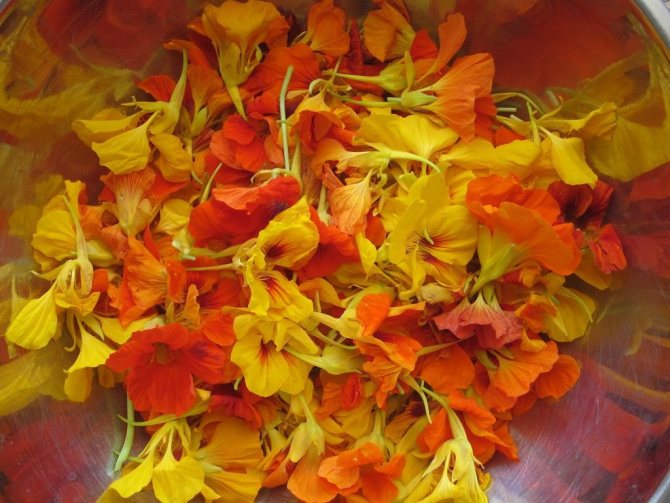

All parts of the plant exude a specific odor that is not repulsive to humans. At the same time, the aroma is unpleasant for insects, therefore nasturtium itself is an insecticide and pests do not bother it. It is also not too sensitive to diseases, only if agricultural technology is violated can rust, gray rot, leaf mosaic, and ring spot develop. Affected shoots and foliage must be cut and destroyed. The rest of the plant is treated with a fungicide.
Existing species and varieties
Nasturtium is represented by a large group of varieties and species.
- Large nasturtium always recognizable in the photo of flowers. As the most popular type, it can be with a double or simple flower, bush or curly. Shrub varieties with a height of 20 cm decorate flower beds, balconies and garden paths.
- Scourge curly nasturtium thanks to the long stems, they create screens covered with large flowers and protect from the sun. They are planted near walls, arches, arbors.
- Dwarf throws out fragile stems covered with small flowers, mostly yellow. Shoots spread along the ground and cover the soil.
- Canary nasturtium noticeably differs from others in stems-vines, curling along the support. Needs an abundance of light, warmth and moisture. Used for vertical gardening.
- Cultured nasturtium obtained from hybrid varieties "Shield-bearing" and "Bolshoi". Tall and dense stems form a large, graceful shrub with purple flowers.


Canary
The list of varieties is popular:
- Vesuvius with large leaves on short stems. The neat bushes are covered with flowers in an orange-pink tone.
- Cherry rose is a bush about 30 cm high, blooming with crimson-pink buds.
- Day-night has attractive creamy red flowers.
- Terry mix with fragrant double flowers of large sizes and bright colors.
- Ladybug has original apricot flowers with specks on the petals. The compact bush is covered with flowers all season. Vesuvius
How to choose varieties?
When planning the planting of nasturtium, it is necessary to choose not only the appropriate color and shape of the flower, the habit of the plant, the ability of the culture to branch, and the nuances of caring for it in the open field are important.
We offer a selection of highly decorative and unpretentious varieties for all kinds of decorating tasks - decorating borders, vertical flower beds, carpet flower beds, flowerpots.
Undersized
This is a group of compact varieties and hybrids, forming neat lush bushes 25-30 cm high. Among low-growing nasturtiums, there are also real dwarfs 15-20 cm high. They are used to frame flower beds and paths, create flower beds, bouquets, planted in small flowerpots, pots.
Examples of varieties:
- Vesuvius is a lush, low variety with dark green foliage. The flowers are salmon pink with orange and red strokes on the petals.
- Tutti Frutti is a variety with large, elegant flowers of a yellow-orange-red palette. Forms a compact bush up to 30 cm, abundantly dotted with flowers.
- Alaska Type Top - undersized series with colors of all shades of orange and red. Differs in unusual foliage - dark green with irregular white spots.
- King Theodore is a plant with a slightly larger habit, forming a bush 40 cm high. In the group, it stands out with large purple flowers with orange strokes along the edge of the petals.
Long-braided (curly)
Long-leaved nasturtiums are sometimes called curly ones, although this is not entirely true. The plant does not have antennae to cling to a support; its branches hang down or spread over the soil at will. Develops lashes 150-200 cm long. This group is perfect for vertical gardening, decoration of terraces, balconies, gazebos. With its help, it is easy to decorate the flaws of buildings.
- Golden Flash is a powerful branchy plant with large golden-yellow flowers. Extends beards up to 150 cm.
- Python - fully justifies the name, growing shoots up to 2 m long. Without support, it covers the soil with a thick lush carpet. Flowers 5-6 cm in diameter, color - red-orange, yellow, pale yellow, terracotta, some corollas come with contrasting strokes along the petals.
- Gloss is a modern hybrid that forms whips up to 3 m. Flowers are large, semi-double, most often in a mixture of colors from beige to purple-burgundy.
- Vasilisa the Beautiful is another hybrid with 3-meter shoots and double flowers.
- Mahogany is a bright medium-sized nasturtium that grows shoots up to 150 cm. The eyes are attracted by double flowers of maroon color up to 7 cm in diameter.
Semi-double and terry
There is a growing interest in planting terry nasturtium hybrids, because with high decorativeness and unusualness, caring for it in the open field is not much different from simple varieties.
- The Purple Legion is a climbing hybrid with layered flowers of deep purple red. Forms shoots 1-1.2 m.
- May Terry Salmon is a delicate, refined nasturtium with two rows of petals in a flower basket.
- Jewel is a semi-double hybrid of the undersized group. Bushes 25–30 cm high are decorated with a cap of velvety flowers of pink and fawn.
Unusual color
Fans of flower novelties will like nasturtiums with an unusual color for us, since planting and caring for them is the same as for other varieties.
- Day and night - mixture of undersized group. An original combination of nasturtium in two colors - cream and maroon.
- Ladybug is a compact bush hybrid with milky flowers, the petals of which are adorned with red spots.
- The Yeti is a climbing nasturtium with cream petals and a yellow heart.
- Creamy strawberries are an original mixture of their red and white flowers with red strokes.
Garden nasturtium care: table
Garden nasturtium cannot be called a capricious flower, but it still requires attention.
| Care steps | Features of the |
| Seat selection | For planting, you need to choose loamy soils with good drainage. Nasturtium is native to the tropics and therefore requires a lot of sunlight. However, it must be protected from direct sunlight. An area where there is a sliding penumbra from tree branches is ideal. |
| Watering | Young plants need frequent and abundant watering. As soon as the first flowers appear, the soil is moistened only when it dries out strongly. Otherwise, instead of flowers, foliage will actively develop, and sometimes the roots may rot. |
| Top dressing | Usually nasturtiums do not need feeding; it is only required on very poor soils. For enrichment, fertilizers are applied before flowering 1 time per week. Complex formulations based on phosphorus are used, and calcareous and organic feedings for nasturtiums are not suitable. |
| Solution of problems | The most common problem with nasturtium is yellowing of the leaves. If it manifests itself at the top of the plant, it may be due to lack of nutrition or excessive soil moisture. If the lower leaves turn yellow, do not worry - this is a normal process. |
| Seed collection | The seeds of nasturtiums are large, ripen about a month after the petals wilt.It is necessary to collect seeds immediately after the fruits turn from green to milk. In this form, they are easily separated from the peduncle. |
| Preparing for winter | Closer to autumn, the plant is watered less and less, then they stop doing it altogether. When the shoots dry up, they need to be removed and the ground dug up. In winter, nasturtium will not survive, so in the spring the seeds are sown again. |
As a rule, nasturtium blooms until the end of August. If you want to extend flowering until November, you need to dig up the plant at the end of the season, transplant it into a flowerpot and put it in the house.
Growing nasturtium from seeds


Sowing
For reproduction of nasturtium, the generative (seed) method is used. It is relatively easy to grow such a plant from seeds. The seeds of nasturtium are large enough. They are sown directly into open soil in the second half of May, while return frosts should be left behind. Make shallow (about 20 mm) holes, between which a distance of 0.25–0.3 m should be maintained. Seeds are sown in a nesting way, with 3 or 4 seeds placed in 1 hole. If it is still cold at night, then the area with crops is covered with any covering material (for example, plastic wrap). Crops should be watered only with lukewarm water. The first seedlings will appear after 7-15 days.
Seedling care
You can also grow nasturtium through seedlings, in which case flowering will occur earlier than when sowing seeds in open soil. For sowing, you need to use cups with a retractable bottom or peat. Seeds are sown in April or May, they are buried in the substrate by 20 mm, while 2 or 3 seeds are placed in 1 cup. Then the cups are rearranged in a cool (from 20 to 22 degrees) place. The first seedlings will appear after about 15 days. The emerging plants should be provided with good lighting so that they do not stretch, otherwise, after transplanting into open ground, they will hurt for a long time and not bloom. Since the root system of nasturtium is rather fragile and weak, and the leaf surface is large, the seedlings are not picked, and the seedlings are planted in open soil directly in cups, without violating the integrity of the earthen coma.
Application
In folk medicine, the fortifying properties of the plant are widely used. Fresh shoots or squeezed juice from them is used to strengthen immunity for colds, sore throat, pneumonia, flu, as well as for symptoms of scurvy. Capuchin is also effective for treating:
- serious pathologies of the respiratory system - asthma, pulmonary emphysema;
- chronic stress and depressive disorders;
- kidney and cholelithiasis;
- diseases of the kidneys and urinary tract;
- disorders of the lymphatic system.
In addition, the plant improves skin condition and helps restore healthy hair and nails. Traditional healers treat burns with nasturtium juice, reduce warts and lipomas. Women suffering from the manifestations of menopause are prescribed to add nasturtium seeds to their food.
"Indian salad" is still popular in cooking. Fresh or slightly stewed capuchin leaves are seasoned with marinades, vegetable stews, hodgepodge. The seeds are pickled and offered to fish dishes and boiled lamb, as a substitute for expensive capers.
Capuchin's insecticidal properties allow gardeners to fight insect pests in an environmentally friendly way. The smell of the plant drives away from the beds of the Colorado potato beetle, aphids, whiteflies for a long time.
The healing properties of nasturtium
However, nasturtium is used not only for picturesque decoration in landscape design. It is also used in cooking and medicine. Scientists have found that all aerial parts of this plant are rich in vitamin C. Fresh nasturtium leaves contain even more of this vitamin than in pepper or black currant.
It also contains carotene and sulfur, which help prevent sclerosis, coronary insufficiency and other diseases that affect the elderly. Nasturtium is also useful for those people who suffer from a lack of iodine, potassium and phosphorus.
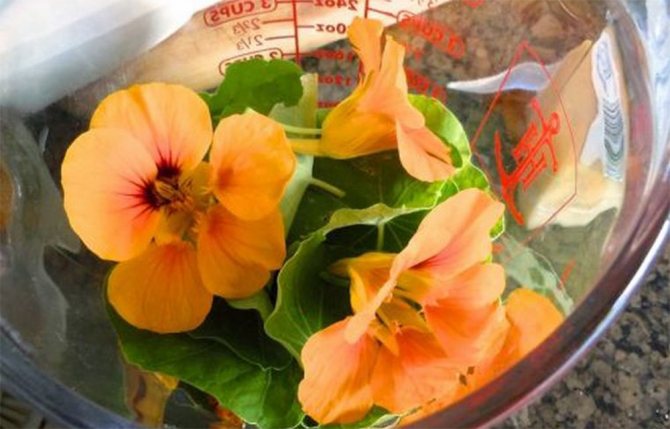

Various drugs are prepared from nasturtium to combat angina and bronchitis.
Preparations are prepared from nasturtium that can cope with angina and bronchitis. In general, this plant is characterized by diuretic, anti-inflammatory and antiscorbutic properties. Nasturtium is also a part of drugs that improve metabolism and reduce irritability, anxiety and depression.
Caring for room nasturtium
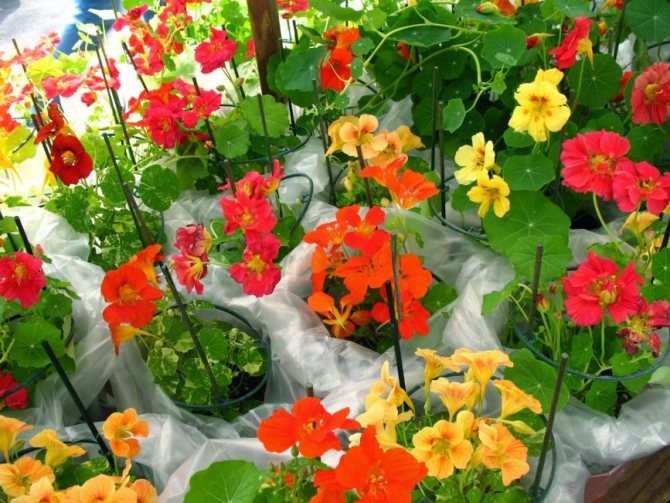

Indoor nasturtium pleases with abundant flowering much longer than garden nasturtium. At home, it can be grown as a perennial. But for a healthy development, she needs to provide decent living conditions.
Content
So that the plant does not experience discomfort, you need to provide:
- air temperature + 20 ... + 25o C (for the winter they are transferred to a cool room with a temperature of + 13 ... + 15o C);
- abundant lighting - it is best to place it on a windowsill on the south or west side;
- normal air humidity (if the room becomes too dry, the plant can be sprayed with a spray bottle).
Closer to spring, the stems stretch out and turn pale. Before returning the pot to a sunny windowsill, the stems must be thoroughly trimmed.
Care
Caring for room nasturtium at home is almost the same as caring for a flower in the ground. The plant requires:
- Watering. Abundant moisture in the process of active growth of shoots and development of buds, in winter water is needed much less often. Pour with settled tap water, to soften, you can add 1 tsp. soda for 2 liters of liquid.
- Top dressing. Every 2 weeks, they are fed with a composition for flowering plants.
- Pruning. As the flowers dry, they are removed; it is also necessary to cut off the shoots so that the nasturtium does not bush too much.
Planting culture
Astilbe flower
Nasturtium is an unpretentious plant. It develops even on poor soil. However, for better growth and lush, long flowering, it is recommended to prepare a bed with fertile loose soil. The most suitable place for culture is sunny and draft-free.


Planting culture
The garden bed is dug up a few weeks before planting. Fertilize with compost, ash, peat. If the soil is heavy, then sand is added to it. The prepared ridge is spilled.
Planting crops can take place both by seeds and seedlings. The seed method is the simplest, but the seedling method will contribute to the prompt start of flowering.
Growing seedlings
- The process begins in March or early April.
- The seeds are placed in a damp cloth for several days.
- They are treated with a solution of manganese and a growth stimulant.
- Small pots or containers are taken. A soil mixture from peat, humus, garden soil is poured into them.
- Seeds are placed in a container with soil mixture to a depth of about 0.7-1.3 cm. In one cup, 2 or 1 seeds are placed.
- Containers or pots are covered with foil or glass. As soon as the shoots look out of the ground, the makeshift greenhouse is removed. The sprouts should hatch in 8-13 days.
- Seedlings should be watered every 2-3 days.
- Before transferring seedlings to open ground, they are hardened. That is, they are taken out into the open air a week before planting, first for 5 minutes, then for 10 minutes, etc. This is to keep the plant under stress after planting.
- Landing in open ground takes place in May, when night frosts pass.
- Each plant is transplanted along with a clod of earth in which the roots are located.
- The distance between adjacent flowers in the garden is about 40 cm.
Planting seeds in the ground
- The event takes place in May.
- Seeds are planted in 1-2 seeds per hole. The holes are made 3 cm deep. The distance between crops is 25 cm.If the planting is in rows, then a distance of 30 cm is left between the rows.
- Further, the seeds are thrown with damp earth.
- The bed is covered with foil.
- Watering is carried out every 2 days.
- When shoots appear, the makeshift greenhouse is removed. But if frost or a sharp drop in temperature suddenly comes, then the film is returned to its place.
Plant requirements for soil, climate
Most of the cultivated species come from warm climates and have similar cultivation requirements.
The best position for nasturtium is a sunny spot, warm, sheltered from the wind.
The soil should be:
- easy;
- moderately fertile (for large nasturtium it can be rather weak);
- slightly damp.
Plants do not tolerate low temperatures, swampy soils, in such conditions they often get sick, inhibit development.
Attention! For nasturtium to bloom profusely, it must grow in relatively poor soil, fertile soil will cause rapid leaf growth by reducing flowering.
Regular garden soil works best. The plant needs a permeable substrate, so one should not forget about the expanded clay layer in the pots.
Nasturtiums planted in the shade almost stop blooming or bloom poorly, so the abundance of sun is an important criterion for choosing the right position in the garden. With less sunlight, the plant quickly spreads over the site, but blooms little.
It is worth immediately planting nasturtium in a permanent place, it does not tolerate damage to the root system and is unlikely to take root in a new place after transplantation.
Growing
There are two ways to propagate nasturtium: by seeds (varietal qualities may not be preserved) and cuttings throughout the summer.
Growing nasturtium from seeds requires patience, since the plant cannot be sown too early - it dies in the slightest frost. In the conditions of central Russia, it is rational to use the seedling method. The seeds are soaked in a small amount of water for a day and buried in peat pots. Picking is not required - young plants are planted in a permanent place right in the pots.
The place for the Capuchin is selected brightly lit, the soil is moderately fertile and well-drained. For abundant flowering several times during the summer, nasturtium must be fed with a mixture of phosphorus and potassium fertilizers. They try not to use nitrogen fertilizers: the plant responds to them with an increase in leaf mass to the detriment of flowering.
Capuchins begin to bloom one and a half months after germination. If this does not happen, you need to determine the reason why the nasturtium does not bloom:
- the soil is oversaturated with nitrogen and organic matter;
- insufficient lighting;
- excess moisture.
Growing and caring for nasturtium involves periodic inspection of the plant for the presence of pests: spider mites and cruciferous fleas. The fight against them consists in the treatment with the "Prophylactin" insecticide.
Diseases of nasturtium can spoil the appearance of the flower garden and infect other species. Capuchins are affected by gray rot, viral mosaic, rust. Fungal and bacterial lesions in the early stages can be treated with Fitosporin and Bordeaux liquid. Viral diseases of nasturtium are not cured - the affected bushes will have to be destroyed and the soil under them completely replaced.


Growing nasturtium
Benefits of nasturtium
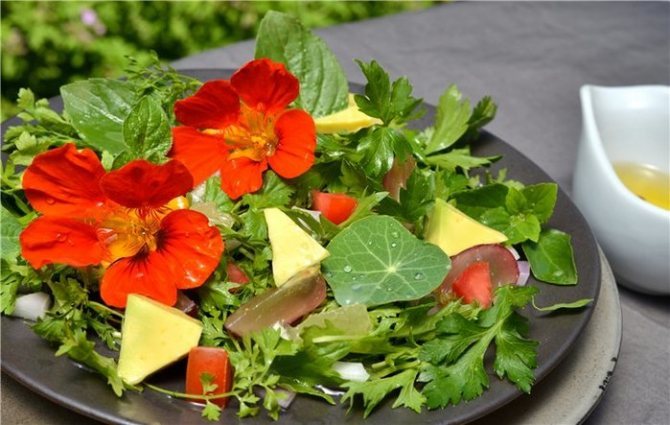

The leaves and flowers of nasturtium are good for human consumption. They are added to salads, soups or sandwiches. The plant tastes refreshing and bitter, similar to watercress. Dried flowers are brewed in the form of tea. Pickled fruits are very similar in taste to capers.
In addition, the plant belongs to medicinal. Nasturtium is a natural antibiotic with a large supply of vitamins and minerals. Infusions are drunk for colds and inflammation of the genitourinary system, they rinse the hair and wipe the face to treat acne.
Seed collection sequence
Usually the flower gives good self-seeding.Under favorable circumstances, it sprouts the next year. If you need to collect seeds, it is best to do it after flowering. It is important to remember that seed germination lasts for 4 years. The most attractive nasturtium flowers should be selected for seed collection. Mature seeds are brown in color. After collecting them, you need to dry them and put them in a paper bag.
Growing from seeds is carried out in the spring, initially containers with planted seeds are installed on a warm windowsill before the first leaves hatch.
Diseases and pests of nasturtium
Parasitic insects are not very fond of the flower, because the smell of its leaves scares them away. However, the plant is still not immune from the attack of some.
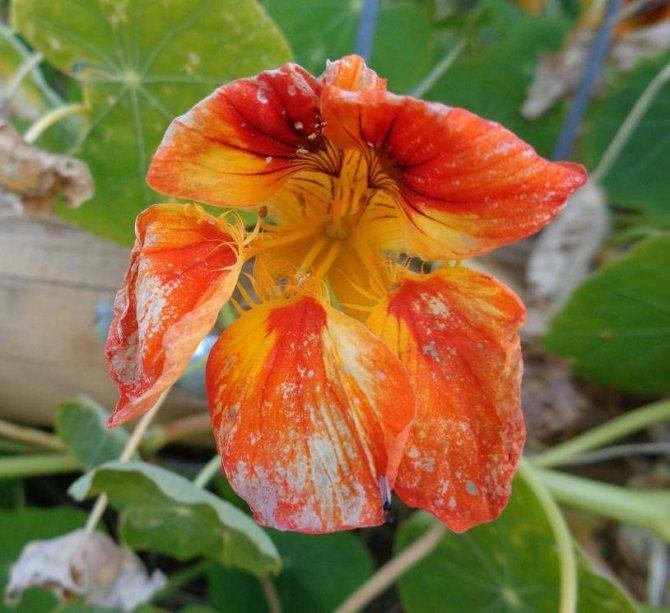

Nasturtium is affected by aphids, plant bugs, in particular, rapeseed bugs, as well as scoop caterpillars.
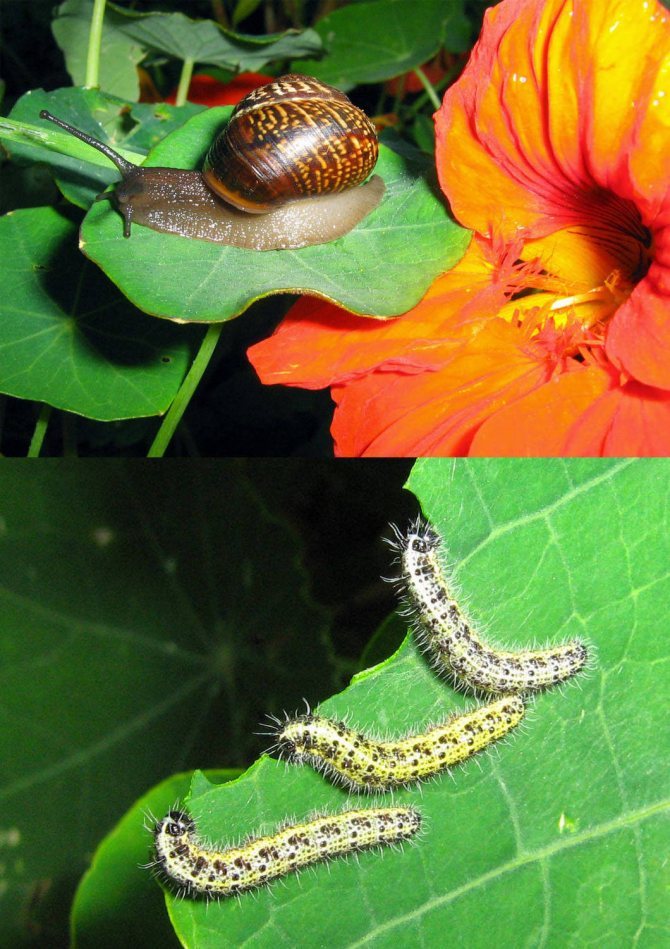

When pests appear, beds with nasturtium are treated with insecticidal preparations, for example, actellik, intavir, karate, fufanon and others.
Among the diseases, the plant is threatened by fungal infections - alternariosis, which manifests itself in rapidly growing brown spots, as well as heterosporia, or speckled spotting of leaf plates.
To prevent planting, nasturtium is sprayed with a Bordeaux mixture, and when the first signs of infection appear, they are treated with antifungal drugs.


Spotted mosaic viral disease begins with the appearance of characteristic mosaic spots and streaks on deformed leaves.
Unfortunately, the affected flowers cannot be cured; they are disposed of so as not to infect neighboring plants.
Diseases, pests and flower care during this period
The uniqueness of nasturtium lies in the fact that it is able to repel such omnivorous pests as whiteflies, aphids and Colorado beetles. That is why it is recommended to plant flowers next to those beds where potatoes, peppers or cabbage are planted. This will not only decorate the personal plot, but will also bring tangible benefits: there will be fewer pests and the harvest will be better preserved. However, nasturtium still has its enemies:
- bacterial wilting. In the affected plant, the lower leaves first disappear, after which the whole plant also perishes;
- gray rot. The disease can be recognized by dry gray-brown spots on the shoots and leaves;
- rust. In a plant affected by this disease, small dark spots appear, which eventually turn into brown or black bumps;
- mosaic. The disease manifests itself on the leaves in a mosaic pattern;
- ring spot. In this disease, the leaves of the plant are covered with small dots surrounded by a dark red border.
If the plant has fallen under the influence of the diseases listed above, then the affected areas should be immediately removed and burned. The remaining specimens must be treated with insecticides.
Nasturtium in landscape design
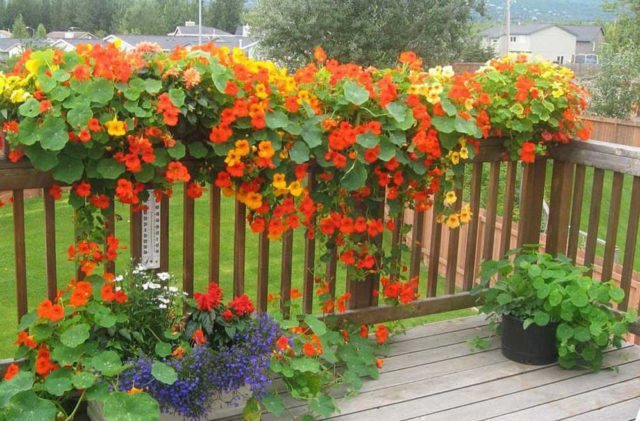

Lianas show themselves well in vertical gardening on trellises or horizontally on the ground. As the plant develops, it turns into a solid green carpet with bright flowers. They look spectacular on flower beds next to delphiniums, bells, ageratum.
Curly nasturtium is an adorable, unpretentious flower. With proper care, the plant will look much more luxuriant and more beautiful than the forgotten wild capuchins. In addition, nasturtium can be eaten and even used as a medicine.
Using nasturtium (video)
Watering the plant
Watering should be systematic, but very moderate, which is most important for young plantings. During flowering, nasturtium is watered only on the driest days; in the standard warm season, watering can be stopped altogether.


How to prolong flowering?
It must be understood that constant abundant watering can lead to rotting of the plant, especially on heavy soils.Therefore, it is worth observing the timeliness of irrigation, but do not forget to do pruning. Removing weak branches and dead buds will significantly prolong flowering.
Using
There are many ways to use nasturtium in the garden. Low-growing varieties of nasturtiums look very good in vases in borders, in various flower beds, as well as in the form of wide ribbons and in containers. As part of flower beds, nasturtiums are capable of creating a picturesque carpet. Curly nasturtium is successfully used for vertical gardening: as decoration of fences, fences, balconies, terraces and pergolas. Creeping nasturtium is excellently used as a ground cover plant, forming picturesque glades.
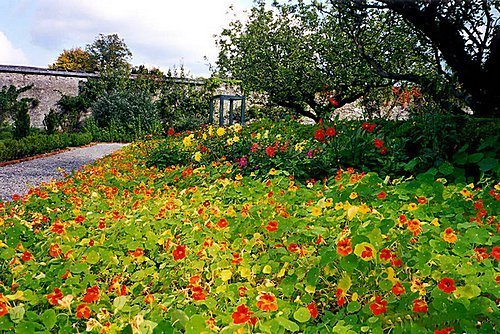

Nasturtium on the site - it all depends on the species
Species and varieties can be radically different. There is a good place for any nasturtium in landscape design. If you have a specific goal, it is enough to choose the most suitable species or variety.
- Shrub nasturtium. Cute annuals are perfect for curbs and mixborders. In addition, they are placed in hanging containers or tubs on the ground, used for balcony landscaping. Large nasturtium (the most common type) is often planted just along the wall near the house or around fruit trees. By the way, on a cabbage bed, a fragrant beauty will save the harvest from a white woman by taking a hit on herself.
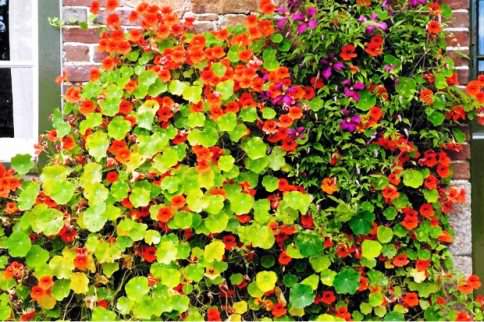

- Curly and ampelous. A chic choice for hedges and all kinds of vertical landscaping. It will add special charm to gazebos and balconies, brighten up the despondency of unsightly fences and walls of the same type, and disguise an old brick building.
- Terry. An annual species noticeably diversifies the territory with bright flowering. You can plant trees on the veranda, balcony and terrace. White or purple petunias are suitable as an addition.
- Climbing nasturtium is grown not only in flower beds, but also at home in pots.
Nutrients for nasturtium
Fertilization and feeding are also necessary for the normal development of nasturtium. True, it is not worth fertilizing the beds intended for it with fresh manure - the plant does not tolerate it. The earth is mixed with rotted manure, but if it is not there, then the store sells special preparations in the form of superphosphate and potassium sulfate. They are brought in quite a bit - per 1 sq. m teaspoon.
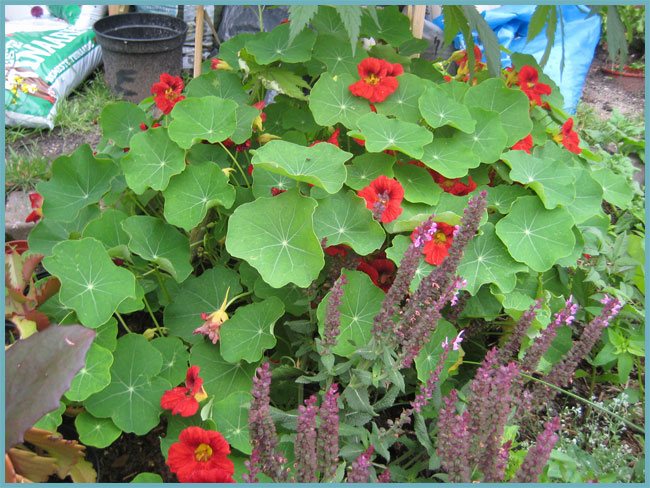

Feed regularly
Before the plant begins to bloom, experts advise feeding with potassium-phosphorus fertilizers in order to cause abundant flowering. Sometimes nasturtium leaves yellowing, and not only the lower ones, but also the upper ones. One of the reasons may be a lack of minerals. Correct the position of the introduction of azofoska.
Attention: do not get carried away with fertilizers containing a lot of nitrogen fertilizers, otherwise nasturtium will not bloom at all or very weakly.


